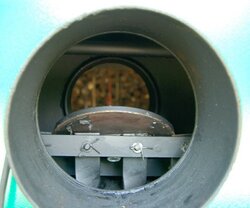I didn't know what these were until I helped slowzuki load up his Jetstream gasification boiler when he drove down here from New Brunswick to pick it up. Ken and the guy selling the boiler showed me the turbulators and explained that they direct the flow of the hot gas through the boiler's heat exchangers in a spiral pattern, which I seem to recall them saying effectively increased the dwell time in the tubes and thus the heat transfer.
I told them about the EKO, which has long sprial-bent pieces of steel in each firetube for cleaning. When you pull the lever on the hx cleaning assembly, these things move up and down (probably about 2 or 3 inches) in the tubes, knocking any accumulated soot back down into the ash pit. They're the same shape as the turbulators in the Jetstream, though they look like mild steel instead of stainless, and are not nearly as smooth or precisely manufactured.
But nonetheless, I suspect they serve a dual function as both turbulators and hx cleaners.
Does anybody know that for sure? Can any of you boiler gurus tell us a bit more about turbulators and their role in boiler design and operation?
I told them about the EKO, which has long sprial-bent pieces of steel in each firetube for cleaning. When you pull the lever on the hx cleaning assembly, these things move up and down (probably about 2 or 3 inches) in the tubes, knocking any accumulated soot back down into the ash pit. They're the same shape as the turbulators in the Jetstream, though they look like mild steel instead of stainless, and are not nearly as smooth or precisely manufactured.
But nonetheless, I suspect they serve a dual function as both turbulators and hx cleaners.
Does anybody know that for sure? Can any of you boiler gurus tell us a bit more about turbulators and their role in boiler design and operation?


